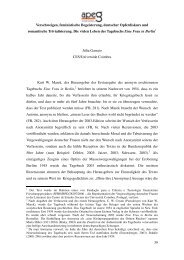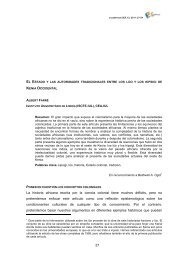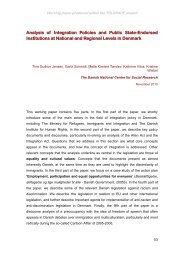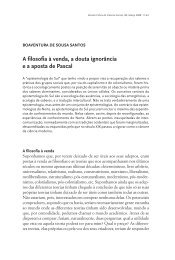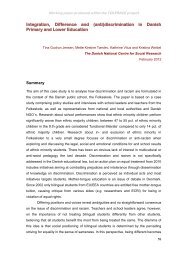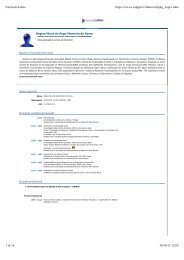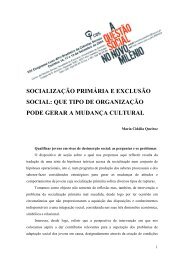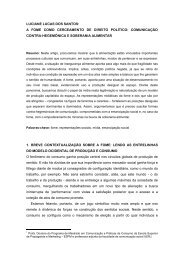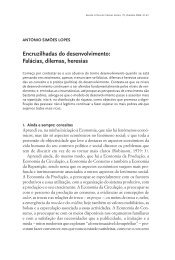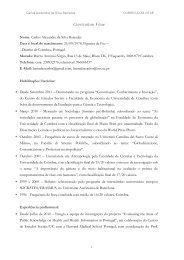The Instrumentalization of Sexual Violence in German Cold War Anti ...
The Instrumentalization of Sexual Violence in German Cold War Anti ...
The Instrumentalization of Sexual Violence in German Cold War Anti ...
You also want an ePaper? Increase the reach of your titles
YUMPU automatically turns print PDFs into web optimized ePapers that Google loves.
RCCS Annual Review, 5, October 2013<br />
<strong>The</strong> <strong>Instrumentalization</strong> <strong>of</strong> <strong>Sexual</strong> <strong>Violence</strong> <strong>in</strong> <strong>German</strong> <strong>Cold</strong> <strong>War</strong> <strong>Anti</strong>-Communist Discourses<br />
Federal Republic’s leagues and associations <strong>of</strong> expellees. 23 In addition to perpetuat<strong>in</strong>g the<br />
image – much cherished <strong>in</strong> expellee circles – <strong>of</strong> East Prussia as a land <strong>of</strong> extreme beauty<br />
destroyed by Soviet rage, the diary, just like Kaps’s text, depicts the <strong>German</strong>s from the<br />
Eastern territories as the blameless victims <strong>of</strong> the crimes committed by National Socialist<br />
<strong>German</strong>y. It fashions them <strong>in</strong>to a paradigm <strong>of</strong> Western Christian culture, a civiliz<strong>in</strong>g hub<br />
embodied <strong>in</strong> a cultured, orderly society, under threat from the East. Both Kaps and<br />
Lehndorff thus demonstrate <strong>in</strong> exemplary fashion how the traumatic experience <strong>of</strong> flight and<br />
expulsion was suffused with religious mean<strong>in</strong>g and lent itself to the anti-communist struggle.<br />
<strong>The</strong> depiction <strong>of</strong> the expellees and <strong>of</strong> the raped women as epitomes <strong>of</strong> a persecuted<br />
Christian culture dissociated them from the National Socialist regime and made them appear<br />
solely as emblems <strong>of</strong> Soviet terror. 24<br />
Thus the homogeneous, terrify<strong>in</strong>g image <strong>of</strong> the Red Army that runs through the accounts<br />
<strong>of</strong> the expellees tended to discredit the <strong>German</strong> Democratic Republic while legitimiz<strong>in</strong>g the<br />
Federal Republic and the Western powers. After <strong>German</strong>y’s complete military defeat <strong>in</strong><br />
1945, <strong>in</strong> the midst <strong>of</strong> all the <strong>in</strong>ternational rivalries, the fears and ideological confrontations<br />
<strong>of</strong> the <strong>Cold</strong> <strong>War</strong>, the stories <strong>of</strong> persecution and abuse at the hands <strong>of</strong> the Red Army and the<br />
descriptions <strong>of</strong> deprivation and economic chaos under Soviet occupation came to be<br />
understood, first and foremost, as evidence <strong>of</strong> the vicious nature <strong>of</strong> communism and <strong>of</strong> its<br />
<strong>in</strong>ability to ensure the well-be<strong>in</strong>g <strong>of</strong> the people. <strong>The</strong>y were also <strong>in</strong>terpreted as signs <strong>of</strong> the<br />
urgent need to jo<strong>in</strong> those Western military and political <strong>in</strong>stitutions that presented<br />
themselves as counterweights vis-a-vis Soviet power and as alternative systems to the<br />
communist economic model. Hence the importance <strong>of</strong> the geographical structure <strong>of</strong> the<br />
accounts: survival only becomes possible with the promise <strong>of</strong> reach<strong>in</strong>g those zones occupied<br />
by the Western Allies. <strong>The</strong> idyllic landscapes to the East might well be lost, but under the<br />
protection <strong>of</strong> the West it was still possible to start anew, liv<strong>in</strong>g with dignity and preserv<strong>in</strong>g<br />
the memory <strong>of</strong> the past. As Lehndorff puts it at the end <strong>of</strong> his diary,<br />
Now it was time to take the first steps on the path that <strong>of</strong>fered me a new existence. And I was<br />
faced with the question: what will this new existence be like, and who will make the decisions<br />
23 On the type <strong>of</strong> memory <strong>of</strong> the past that was dom<strong>in</strong>ant with<strong>in</strong> the leagues, see, for <strong>in</strong>stance, Hahn and Hahn<br />
(2003: 338-51), Moeller (2001: 51-87) and Münz and Ohliger (2003: 380-1).<br />
24 A number <strong>of</strong> studies show how the <strong>Cold</strong> <strong>War</strong> favored the appropriation, <strong>in</strong> the Federal Republic, <strong>of</strong> flight and<br />
expulsion as a collective <strong>German</strong> experience, and argue that this site <strong>of</strong> memory was given a central role <strong>in</strong> the<br />
construction <strong>of</strong> a national identity as a people <strong>of</strong> victims (see, e.g., He<strong>in</strong>eman, 1996; Moeller 2001; Moeller,<br />
2006a; Ohliger and Münz, 2003: 384-5; Schmitz, 2007).<br />
56




